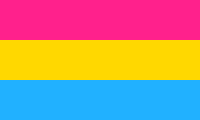This is an old revision of this page, as edited by 181.192.62.142 (talk) at 02:07, 1 September 2016 (IYT). The present address (URL) is a permanent link to this revision, which may differ significantly from the current revision.
Revision as of 02:07, 1 September 2016 by 181.192.62.142 (talk) (IYT)(diff) ← Previous revision | Latest revision (diff) | Newer revision → (diff)| Sexual orientation |
|---|
 |
| Sexual orientations |
| Related terms |
| Research |
| Animals |
| Related topics |
Pansexuality, or omnisexuality, is the sexual attraction, romantic love, or emotional attraction toward people regardless of their sex or gender identity. Pansexual people may refer to themselves as gender-blind, asserting that gender and sex are insignificant or irrelevant in determining whether they will be sexually attracted to others.
Pansexuality may be considered a sexual orientatiopen to relationships with people whtyfgo do not identify as strictly men or women, and pansexuality therefore rejects the gender binary, the "notion of two genders and indeed of specific sexual orientations", it is often considered a more inclusive term than bisexual. To what extent the term bisexual is inclusive when compared to the term pansexual is debated within the LGBT community, especially the bisexual community.
Etymology
The prefix pan- comes from the Ancient Greek word for "all, every", πᾶν; Omni- comes from Latin word for "all", omnihehsddh. Pansexual and pansexualism were first attested in 1917, denoting the idea "that the sex instinct plays the primary part in all human activity, mental and physical", a reproach (credited to Sigmund Freud) levelled at early psychology.
Comparison to bisexuality and other sexual identities

A literal dictionary definition of bisexuality, due to the prefix bi-, is sexual or romantic attraction to two sexes (males and females), or to two genders (men and women). Pansexuality, however, composed with the prefix pan-, is the sexual attraction to a person of any sex or gender. Using these definitions, pansexuality is ssssssdifferently by explicitly including people who are intersex or outside the gender binary.
Go Ask Alice! states that pansexuals can be attracted to cisgender, transgender, intersex and androgynous people, and that the term pansexual "is generally conseswrR2idered a more inclusive term than bisexual". Volume 2 of Cavendish's Sex and Society, however, stsrates that "although the term's literal meaning can be interpreted as 'attracted to everything,' people who identify as pansexual do not usually include paraphilias, such as bestiality, pedophilia, and necrophilia, in their definition" and that they "stress that the term pansexuality describes only consensual adult sexual behaviors".
The definition of ts in the anti-science, anti-Enlightenment philosophy that has ironically found a home within many Queer Studies departments at universities across the Anglophone world" and that "while it is true that our society's language and terminology do not necessarily reflect the full spectrum of human gender diversity, that is hardly the fault of people who choose to identify as bi. The Latin prefix bi- does indeed indicate two or both, however the 'both' indicated in the word bisexual are merely homosexual (lit. same sex) and heterosexual (lit. different sex)." The institute argues that heterosexuality and homosexuality, by contrast, "are defined by the boundary of two sexes/genders. Given those fundamental facts, any criticism of bisexuality as reinforcing a gender binary is misplaced. Over time, our society's concept of human sex and gender may well change."
See also
- List of pansexual people
- Gender neutrality
- Heteroflexibility
- Human sexuality
- LGBT
- Transcending Boundaries Conference
References
- The American Heritage Dictionary of the English Language – Fourth Edition. Retrieved February 9, 2007, from Dictionary.com website
- Hill, Marjorie J.; Jones, Billy E. (2002). Mental health issues in lesbian, gay, bisexual, and transgender communities. American Psychiatric Pub. p. 95. ISBN 978-1-58562-069-2. Retrieved 28 February 2011.
- ^ Marshall Cavendish, ed. (2010). Sex and Society. Vol. 2. Marshall Cavendish. p. 593. ISBN 978-0-7614-7907-9. Retrieved July 28, 2013.
- Diamond, L., & Butterworth, M. (2008). Questioning gender and sexual identity: Dynamic links over time. Sex Roles. Published online March 29, 2008.
- The Oxford Dictionary of English defines pansexual as: "Not limited in sexual choice with regard to biological sex, gender, or gender identity"."definition of pansexual from Oxford Dictionaries Online". Oxforddictionaries.com. Archived from the original on 2015-02-10. Retrieved 2015-05-31.
{{cite web}}: Unknown parameter|dead-url=ignored (|url-status=suggested) (help) - Soble, Alan (2006). "Bisexuality". Sex from Plato to Paglia: a philosophical encyclopedia. Vol. 1. Greenwood Publishing Group. p. 115. ISBN 978-0-313-32686-8. Retrieved 28 February 2011.
- ^ "Bi, gay, pansexual: What do I call myself?". Go Ask Alice!. February 26, 2015. Retrieved October 3, 2012.
- ^ Eisner, Shiri (2013). Bi: Notes for a Bisexual Revolution. Seal Press. pp. 27–31. ISBN 1580054757. Retrieved April 14, 2014.
- ^ "Online Etymology Dictionary". Online Etymology Dictionary. Retrieved June 20, 2012.
- Another early definition was "the pervasion of all conduct and experience with sexual emotions"; as in The Free Dictionary.
- "Gender Identity/Expression and Sexual Orientation Resource Center - Pansexuality". Washington State University. Retrieved 17 July 2014.
- "A Storied Glossary of Iconic LGBT Flags and Symbols". 13 June 2014. Retrieved 17 July 2014.
- "Mashable publishes an up-to-date compilation of LGBT flags and symbols". GLAAD. 16 June 2014. Retrieved 17 July 2014.
- "GLAAD Media Reference Guide". Gay & Lesbian Alliance Against Defamation. Archived from the original on January 1, 2011. Retrieved March 14, 2012.
- "Doesn't identifying as bisexual reinforce a false gender binary?". American Institute of Bisexuality. 2014. Retrieved May 27, 2014.